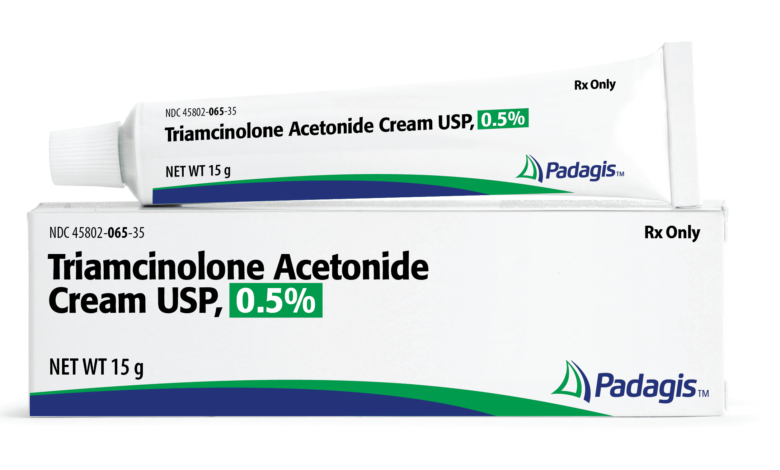Triamcinolone Acetonide Cream: A Comprehensive Guide to Uses, Benefits, and Side Effects 2024

Triamcinolone acetonide cream is a topical medication often prescribed by dermatologists for various inflammatory skin conditions. Used to manage symptoms like itching, redness, and swelling, this cream has gained significant popularity due to its efficacy in providing quick relief. In this comprehensive guide, we’ll dive deep into everything you need to know about triamcinolone acetonide cream—from its uses and benefits to possible side effects and tips for safe application.
Understanding the benefits and risks associated with triamcinolone acetonide cream can be empowering for those with chronic skin issues. Let’s explore this medication and why it’s become a go-to option for skin inflammation.
What is Triamcinolone Acetonide Cream?
Triamcinolone acetonide cream is a medium-strength corticosteroid used to reduce inflammation and suppress immune responses in the skin. It is available in various strengths, with the most common strengths being 0.025%, 0.1%, and 0.5%. Each strength is prescribed based on the severity of the skin condition.
Primarily, triamcinolone acetonide cream is formulated to target and soothe inflammation in the skin, making it effective for conditions like eczema, psoriasis, and other allergic reactions. The medication works by blocking the release of substances that cause inflammation in the body, leading to a reduction in swelling, itching, and redness.
In its different forms (cream, lotion, ointment), triamcinolone acetonide is highly versatile and can be adapted to meet the needs of each patient’s skin type and specific condition. The cream, in particular, is favored for its easy application and quick absorption.
How Does Triamcinolone Acetonide Cream Work?

Triamcinolone acetonide cream is part of a class of medications called corticosteroids, which are synthetic versions of hormones naturally produced by the adrenal glands. The cream works by mimicking the action of cortisol—a hormone responsible for managing inflammation and immune responses in the body.
When applied to the skin, triamcinolone acetonide cream interacts with specific receptors in the skin cells, decreasing the release of inflammatory substances like prostaglandins and leukotrienes. By doing so, it helps reduce symptoms such as itching, swelling, and redness associated with inflammatory skin disorders.
The cream is also designed to have a localized effect, meaning it works primarily on the area it’s applied to, with minimal absorption into the bloodstream. This localized action allows it to provide effective relief without causing widespread side effects in the body.
Common Uses of Triamcinolone Acetonide Cream
Triamcinolone acetonide cream is prescribed for various skin issues due to its anti-inflammatory properties. Some of the most common conditions it’s used to treat include:
- Eczema: This chronic skin condition causes dry, itchy, and inflamed skin. Triamcinolone acetonide cream can help relieve eczema symptoms by reducing itching and inflammation.
- Psoriasis: Characterized by red, scaly patches on the skin, psoriasis can be challenging to manage. The cream helps reduce the severity of these patches, making the skin feel smoother and less irritated.
- Contact Dermatitis: For those who experience allergic reactions from contact with certain substances, triamcinolone acetonide cream can help manage the resulting rashes and irritation.
- Other Skin Allergies: Triamcinolone acetonide cream is also effective for treating mild to moderate allergic reactions on the skin.
By addressing these and other inflammatory skin conditions, triamcinolone acetonide cream has become a reliable treatment option for people dealing with persistent skin irritation.
Benefits of Triamcinolone Acetonide Cream
The benefits of triamcinolone acetonide cream are notable, particularly for those with chronic or recurring skin conditions. Here are some of the top benefits:
- Quick Symptom Relief: One of the standout benefits is the cream’s ability to provide fast relief from itching, redness, and swelling, which can be highly beneficial during flare-ups.
- Versatile Treatment Option: Available in multiple strengths, triamcinolone acetonide cream can be tailored to different severity levels, from mild to moderate conditions.
- Localized Action: Since it works directly on the skin, it doesn’t circulate widely in the bloodstream, which can reduce the likelihood of systemic side effects.
- Moisturizing Effect: Many users find that the cream formulation adds moisture to the skin, which can be especially helpful for conditions like eczema where skin dryness is a major symptom.
These benefits have contributed to the cream’s reputation as an effective and manageable treatment option for people with a range of skin conditions.
Dosage and Application Guidelines for Triamcinolone Acetonide Cream
When using triamcinolone acetonide cream, it’s essential to follow prescribed dosage instructions to ensure effective results without unwanted side effects. Generally, dermatologists recommend applying a thin layer to the affected area once or twice daily, depending on the severity of the condition.
- Application: Always clean and dry the skin before applying the cream. Avoid covering the treated area with a bandage unless directed by a healthcare provider, as this can increase absorption and the risk of side effects.
- Duration: For most people, triamcinolone acetonide cream should not be used for prolonged periods unless otherwise advised by a healthcare provider. Chronic use can increase the risk of side effects and skin thinning.
- Areas of Use: It’s typically not recommended for sensitive areas, such as the face or groin unless prescribed specifically for these areas. Stronger steroid creams are not suitable for sensitive skin due to potential irritation.
Following these guidelines can help ensure that users achieve the best possible outcomes with minimal risks.
Side Effects and Risks of Using Triamcinolone Acetonide Cream

While triamcinolone acetonide cream is generally safe, it can cause side effects, especially with prolonged use. Common side effects include:
- Skin Thinning: Extended use of the cream can thin the skin, making it more fragile and prone to damage.
- Increased Sensitivity: Some users may experience heightened sensitivity to sun exposure or other irritants.
- Allergic Reactions: In rare cases, individuals may have an allergic reaction to the cream, causing more redness, itching, or swelling in the treated area.
In addition to these potential side effects, the risk of side effects can be minimized by using the cream only as directed and avoiding overuse. If you experience any unusual symptoms while using triamcinolone acetonide cream, consult a healthcare provider promptly.
Triamcinolone Acetonide Cream for Eczema
Triamcinolone acetonide cream is a popular choice for managing eczema symptoms, as it provides fast relief from itching and irritation. Eczema, a chronic condition characterized by dry, inflamed skin, often requires consistent management with topical treatments.
The cream works by reducing inflammation in the affected areas, which helps soothe the skin and prevent further flare-ups. It is especially useful during acute eczema flare-ups when symptoms like redness, swelling, and severe itching are at their peak.
For best results, it’s recommended to combine triamcinolone acetonide cream with a good skincare routine, including moisturizers that help keep the skin hydrated and protected.
- Triamcinolone Acetonide Cream for Psoriasis
Psoriasis is a challenging skin condition marked by red, scaly patches that often feel itchy and uncomfortable. Triamcinolone acetonide cream is widely prescribed for psoriasis, as it can help reduce the severity and size of the patches, improving the skin’s appearance and comfort.
This cream works by reducing inflammation and slowing the production of skin cells, which can prevent the buildup of scaly patches. For individuals with mild to moderate psoriasis, triamcinolone acetonide cream may be an effective standalone treatment. However, for more severe cases, it might be used in conjunction with other therapies.
- Triamcinolone Acetonide Cream for Skin Allergies
Skin allergies can manifest as redness, itching, and swelling, often triggered by contact with allergens like plants, metals, or other substances. Triamcinolone acetonide cream is commonly used for managing these allergic reactions on the skin, providing soothing relief and reducing visible symptoms.
Applying the cream to the affected area helps control the body’s immune response, calming the redness and swelling. For those with a history of skin allergies, having triamcinolone acetonide cream on hand can be a practical way to manage symptoms quickly and effectively.
Who Should Avoid Using Triamcinolone Acetonide Cream?
While triamcinolone acetonide cream is effective for many people, certain individuals should avoid using it. Those who should refrain from using this cream include:
- Pregnant or Breastfeeding Women: Corticosteroids can sometimes affect fetal development, so it’s best to consult a doctor before use.
- Children: Since children’s skin absorbs corticosteroids more readily, they may be at a higher risk of side effects.
- People with Certain Skin Conditions: Those with conditions like rosacea or acne should avoid triamcinolone acetonide cream, as it could exacerbate these issues.
Before beginning treatment with, it’s important to discuss any pre-existing health concerns with a healthcare provider to determine if it’s a safe option.
Triamcinolone Acetonide Cream: Drug Interactions
Triamcinolone acetonide cream has relatively few drug interactions since it’s applied topically. However, in some cases, it can interact with other medications, especially if used over large skin areas where absorption might be higher.
- Immunosuppressive Drugs: Since both suppress the immune system, combining them can increase the risk of infection.
- Other Corticosteroids: Using multiple corticosteroid medications simultaneously can increase the risk of side effects, so it’s best to avoid doing so unless specifically advised.
Discussing your medication history with a healthcare provider will help you avoid any interactions that could compromise the cream’s efficacy or safety.
How to Safely Use Triamcinolone Acetonide Cream for Children and Older Adults
For children and older adults, requires careful monitoring due to the possibility of heightened absorption and side effects. Here are some special considerations:
- Children: Their skin is thinner and more permeable, which means the cream might absorb more easily, leading to an increased risk of side effects.
- Older Adults: Older individuals may also experience increased skin sensitivity and should use the cream sparingly, especially on delicate areas.
With proper guidance and caution, both children and older adults can benefit from the cream’s therapeutic effects without unnecessary risks.
Triamcinolone Acetonide Cream vs. Other Steroid Creams
When comparing to other corticosteroids, it is often viewed as a medium-potency option that’s versatile and well-suited for many inflammatory skin conditions.
- Hydrocortisone: A milder corticosteroid, suitable for less severe conditions.
- Betamethasone: Stronger than triamcinolone, reserved for severe cases and areas that require extra strength.
Choosing the right corticosteroid strength is essential, and is often preferred for cases that fall between mild and severe.
Tips for Effective Use of Triamcinolone Acetonide Cream
To make the most out of triamcinolone acetonide cream, here are a few tips:
- Follow Directions: Always use the cream as prescribed, following the specific application instructions from your healthcare provider.
- Moisturize Regularly: Pair the cream with a gentle, fragrance-free moisturizer to keep skin hydrated.
- Avoid Sensitive Areas: Unless directed, avoid applying the cream on the face, armpits, or groin, as these areas are more sensitive.
Following these tips can help you achieve better results and reduce the likelihood of adverse reactions.



